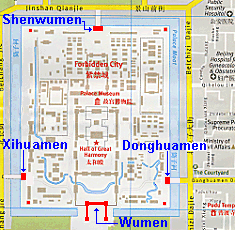The Birdcages


The base on which each one of the corner towers sits forms a rectangular-shaped platform which can be seen on the picture at the bottom of this page.
The superstructure is of a highly complex design in a so-called nine-beam, eighteen-column and seventy-two-ridge style. The roof has 3 layers of eaves, is covered with a variety of differently shaped yellow-glazed tiles and has a gold tip in the center of the top.
Dilapidation of the palaces, royal buildings and gates was widespread in the wake of the fall of the Qing dynasty in 1911. In the pictures, the doors and windows are missing giving a rather desolate impression of the once so glorious building.
According to an old Chinese tale Emperor Yongle's chief engineer had great difficulty coming up with a design beautiful enough for the corner towers of the Palace City. The emperor had insisted on a design architecturally superior to any other current or previous Chinese corner towers.
On the eve of having to present his proposal to the emperor, the chief designer sat in a Beijing tea house, desperate and completely out of ideas. He knew that failure would mean certain death.


Suddenly a heavily bearded old man walks into the tea house with a bird cage in his hand. But it was no ordinary bird cage. It had the most elegant design that the chief engineer had ever seen. He promptly approached the old man and struck a deal to buy the bird cage and next morning he presented it as his tower model to the emperor. The emperor was delighted with the magnificent design which is the same that we can still enjoy today.
The legend has it that the old man was no other than the Yongle emperor himself!!
How to Find it Today?
You cannot miss them if you go to The Forbidden City in Beijing's center. They beautifully decorate each corner of the Place City wall.
For the two southern towers you can get all the way up to the wall on which they stand on the encircling road.
The Giant Wooden Bridge
The park just southwest of the southern palace moat bridge used to be the temple for the God of Land and the God of Grain during Ming and Qing.
In 1914 it was made into a park named Zhong Shan Park in honor of Sun Zhongshan -in the West known as Sun Yatsen -the father of Modern China.

In 1915 a back door was opened in the park's northern wall and a long, wide wooden bridge built from the park to Xihua Gate across the palace moat.
The wooden gate and the ticket house in the northern end of the bridge can both be seen in the pictures. Tickets were sold to enter the park or to enter the display of antiques in Xihuamen.
The bridge has long since been dismantled and the area returned to its original layout from 1420.



